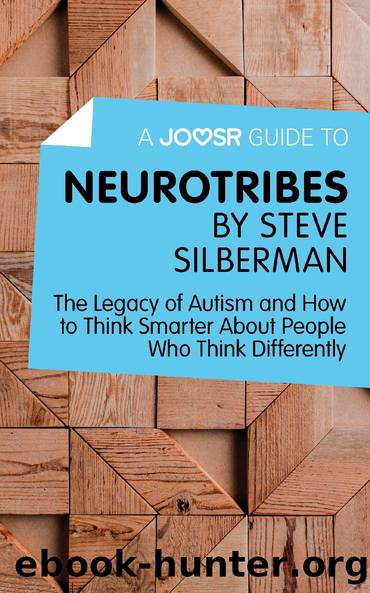Neurotribes by Steve Silberman

Author:Steve Silberman
Language: eng
Format: epub
Publisher: Joosr Ltd
Although they have much to contribute to society, autistic people have suffered injustice for many years
Tragically, autism was discovered during a time when eugenics was a buzz topic in the USA and Europe. In Austria, Hitler’s National Socialist party was in power, causing a media panic by spreading propaganda depicting mentally ill people as a menace to society, a drain on state resources, and a corruptive influence in constructing the pure race.
Citizens judged to be mentally disabled were transported to special clinics—a decision that was often based on a single IQ test reviewed by a panel of experts in Berlin. Many autistic people were among these. These clinics were little more than concentration camps. Between 1939 and 1944, 789 children were murdered at one Austrian clinic alone. The medical staff employed various methods to achieve this: lethal injections, exposure, experimentation, and starvation.
Later, across the Atlantic in the US, children diagnosed with autism—or childhood schizophrenia—were taken from their families and placed in hospitals or asylums. There they were subjected to various treatments and experimental methods in an attempt to cure what ailed them. Some were given courses of ECT (electroconvulsive therapy), a shock treatment whereby electric currents are administered to the brain, causing a brief seizure. Others were administered daily doses of psychotic drugs such as LSD and Benzedrine. Many of these experimental trials went uncontrolled and unmonitored; doctors were not even required to submit justification or hypotheses to gain permission. Once admitted to such an institution, the odds of ever getting out were low.
Children who managed to avoid asylums often grew up to become high-functioning adults, especially when opportunities to develop their gifts arose. Just one of many examples was the patient referred to as Robert S. in Kanner’s studies, who became a meteorologist in the navy. Staying in an institution meant not only being experimented on, but also becoming institutionalized. The lack of creative space and opportunity proved detrimental to an autistic mind. Autistic children did not need a therapy or a cure; they needed a supportive environment that allowed them the chance to utilize their talents.
In the 1930s and 1940s, autistic people suffered at the hands of eugenics-obsessed Nazis. Later, they were taken advantage of by doctors in mental health institutions, although those who were allowed to use their gifts flourished and were able to contribute to society—which leads us up to the present day.
Download
This site does not store any files on its server. We only index and link to content provided by other sites. Please contact the content providers to delete copyright contents if any and email us, we'll remove relevant links or contents immediately.
| Allergies | Asthma |
| Autism & Asperger's Syndrome | Cystic Fibrosis |
| Down Syndrome | Eating Disorders |
| Epilepsy | Learning Disorders |
| Lice | Special Needs Children |
I Capture the Castle by Dodie Smith(1579)
Aspergirls by Rudy Simone(1366)
Be Different by John Elder Robison(1334)
Autism's False Prophets by Paul A. Offit(1245)
My Child's Different by Elaine Halligan(1233)
Smart but Scattered—and Stalled by Richard Guare(1199)
101 Tips for the Parents of Boys with Autism by Ken Siri(1158)
What's Making Our Children Sick? by Michelle Perro(1158)
Asperger Syndrome (Autism Spectrum Disorder) and Long-Term Relationships by Ashley Stanford(1118)
ADHD by Mark Selikowitz(1109)
An Adult with an Autism Diagnosis by Gillan Drew(1074)
Girlish by Lara Lillibridge(1072)
Nerdy, Shy, and Socially Inappropriate by Cynthia Kim(1059)
Animal-assisted Interventions for Individuals with Autism by Temple Grandin(1040)
On Immunity: An Inoculation by Biss Eula(1032)
Seeing Ezra by Kerry Cohen(1015)
Overcoming ADHD by Stanley I. Greenspan & Jacob (con) Greenspan(995)
Why Gender Matters by Leonard Sax M.D. Ph.D(984)
Sarah's Child (Hqn Romance) by Linda Howard(983)
